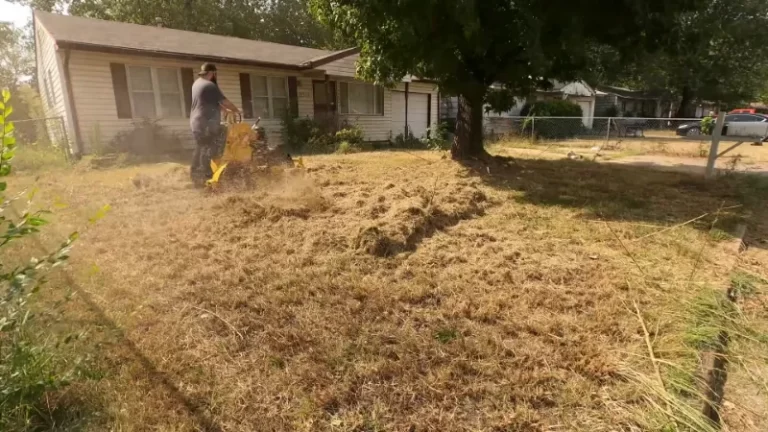Reel Mower vs Gas: The Brutal Truth Your Lawn Needs You to Know
Choosing a lawn mower feels like it should be simple. Yet, homeowners often find themselves paralyzed by choice, facing a decision that will impact their wallet, their free time, and the very health of their lawn. The wrong mower can lead to damaged grass, frustrating maintenance routines, and even neighborly disputes over noise.
This guide cuts through the confusion, focusing on two classic contenders: the timeless manual reel mower and the powerful gas-powered rotary mower. Each represents a completely different philosophy of lawn care. One is about precision and health; the other is about power and speed.
Understanding the fundamental differences between these two machines is the first step toward achieving the lawn you’ve always wanted. It’s a choice that goes far beyond how you cut your grass—it defines your entire approach to yard maintenance.
You'll Learn About
The Crucial Difference: How They Cut
The single most important distinction between a reel mower and a gas mower is the cutting mechanism. This mechanical difference is the source of nearly all the pros and cons for each type and directly impacts the health and appearance of every blade of grass on your lawn.
A reel mower uses a series of blades that rotate in a cylinder, trapping and slicing the grass against a stationary bed knife. This creates a clean, precise, scissor-like cut. This action is identical to how scissors work, providing a sharp, clean edge that allows the grass to heal quickly.
In stark contrast, a gas mower uses a single horizontal blade that spins at an incredibly high speed. A gas mower’s rotary blade chops or tears the grass. This high-impact method relies on brute force to sever the grass blades, which can leave them with ragged, frayed tips.
Microscopic Lawn Damage: The Unseen Battle
While both mowers cut the grass, the results at a microscopic level are vastly different. The clean slice from a reel mower minimizes the surface area of the wound on the grass blade. This helps the plant conserve moisture, heal faster, and makes it less vulnerable to diseases and pests.
The tearing action of a rotary mower creates a larger, more jagged wound. This stresses the plant, causes greater moisture loss (leading to brown tips), and creates an easier entry point for fungal diseases and insects. Proper blade sharpness on a gas mower can reduce this damage, but the fundamental mechanism is still more violent than a reel mower’s scissoring action.
Effort, Ease of Use, and The Sunday Morning Experience
The user experience with a reel mower versus a gas mower is a study in contrasts. One offers quiet, engaged physical effort, while the other provides loud, powerful convenience that comes with its own set of burdens.
A common misconception about manual reel mowers is that they are incredibly difficult to push. While older, heavy models from decades past earned this reputation, modern reel mowers are lightweight and engineered for efficiency. They aren’t effortless, but for a small to medium-sized, relatively flat lawn, the effort is comparable to a brisk walk.
The challenge with a reel mower arises when the lawn is neglected. They struggle with tall grass and thick weeds, which tend to get pushed over rather than cut. This demands a more consistent mowing schedule—often twice a week during peak growing seasons—to keep the grass at a manageable height. If you enjoy the routine and the light exercise, this is a benefit, not a drawback.

The Power and Problems of Gas Mowers
Gas mowers, especially self-propelled models, undeniably require less physical pushing effort. They can power through tall, thick grass and weeds with ease, making them the practical choice for large or overgrown properties. However, this power comes at the cost of a pleasant user experience.
Gas mowers are loud, heavy, and produce significant vibrations. The noise can easily exceed levels that are comfortable for both the operator and the neighbors. The sheer weight makes them cumbersome to maneuver in tight spaces, and the constant engine vibration can be fatiguing over time.
Lawn Health and Aesthetics: A Clear Winner Emerges
If the ultimate goal is the healthiest, most visually appealing lawn, the reel mower has a distinct advantage. The cutting method directly translates into a greener, more resilient turf that mimics the appearance of a golf course putting green.
The scissor-like cut seals the grass blade, promoting rapid healing and a lush, uniform appearance. This healthy cut makes the grass less susceptible to browning and disease. Because reel mowers can be set to a lower cutting height without scalping the lawn, they are ideal for achieving a manicured, carpet-like finish, especially on grass types like Bermuda and Zoysia.
A gas-powered rotary mower, even with a sharp blade, can leave the lawn with a slightly frayed look. This damage can lead to brown tips and increased stress on the turf. The vacuum effect created by the rotary blade is often touted as a benefit for picking up leaves, but it can also suck up weed seeds and distribute them across the lawn.
Cost of Ownership: The Full Financial Picture
When comparing the costs of a reel mower and a gas mower, it’s essential to look beyond the initial purchase price. The long-term expenses associated with fuel, maintenance, and repairs reveal a significant financial gap between the two options.
A manual reel mower is a one-time purchase. There are no ongoing fuel or oil costs. Maintenance is minimal, typically involving an annual blade sharpening or adjustment, which can often be done at home. This makes the reel mower the undisputed champion of low-cost, long-term ownership.
A gas mower has a higher initial cost and a continuous stream of associated expenses. These include the weekly cost of gasoline, regular oil changes, and the replacement of parts like spark plugs, air filters, and fuel filters. These “hidden costs” add up significantly over the mower’s lifespan.
Comparative Cost Breakdown
The following table provides a clear overview of what you can expect to spend and deal with over the life of each mower type.
| Feature | Reel Mower | Gas Mower |
|---|---|---|
| Initial Purchase Price | $100 – $300 | $300 – $700+ |
| Annual Fuel & Oil Costs | $0 | $35 – $100+ |
| Annual Maintenance | Blade adjustment/sharpening ($0 – $30) | Oil, spark plug, filters ($25 – $85) |
| Noise Level | Very Quiet (50-60 dB) | Very Loud (90-100+ dB) |
| Emissions | Zero | Significant CO, VOCs, NOx |
| Best For Lawn Health | Excellent (Clean Scissor Cut) | Fair (Tearing Action) |
| Best Lawn Size | Small to Medium (< 1/2 acre) | Medium to Large (> 1/4 acre) |
| Storage Footprint | Small, can be wall-hung | Large, requires floor space |
Environmental and Neighborhood Friendliness
The choice between a reel and gas mower also has a significant impact on the environment and your relationship with your neighbors. In this regard, the reel mower is the far more responsible choice. It produces zero emissions and is exceptionally quiet.
Operating a reel mower is a peaceful experience, allowing you to listen to music, a podcast, or simply the sounds of nature. You can mow early in the morning or later in the evening without disturbing anyone. For those interested in greener solutions, comparing a reel mower vs electric model is a logical next step in eco-friendly lawn care.
Conversely, gas-powered lawn equipment is a major source of air and noise pollution. According to the U.S. Environmental Protection Agency (EPA), running a typical gas mower for one hour can produce the same amount of air pollution as driving a car for hundreds of miles. The noise generated is not just an annoyance; it contributes to noise pollution that can be disruptive to wildlife and the community.
Choosing Your Champion: Which Mower Fits Your Life?
The best mower for you depends entirely on your lawn size, grass type, and personal priorities.
You should choose a reel mower if:
- You have a small to medium-sized lawn (typically under 5,000 square feet).
- Your lawn is relatively flat and free of major obstacles.
- Lawn health and a pristine cut are your top priorities.
- You are environmentally conscious and want to avoid noise and air pollution.
- You don’t mind a light workout and can stick to a regular mowing schedule.
You should choose a gas mower if:
- You have a large lawn (over 1/2 acre).
- Your terrain is hilly, uneven, or covered in tough weeds and thick grass.
- Speed and power are more important to you than cut quality.
- You often let the grass grow tall between mowings.
- The noise, emissions, and maintenance are acceptable trade-offs for convenience.
Advanced Considerations for the Lawn Enthusiast
For those who want to dive deeper, a few more factors can influence your decision. The type of grass you have is a major consideration. Reel mowers excel on dense, finer-bladed grasses that are cut low. They can sometimes struggle with tougher, thicker-bladed warm-season grasses if the blades aren’t perfectly sharp and adjusted.
Perfecting the blade contact on a reel mower is a critical skill. A properly adjusted mower will cleanly slice a single sheet of paper inserted between the reel and the bed knife. This simple test ensures the mower is cutting with maximum efficiency and minimum effort. This is a level of hands-on maintenance that gas mower owners rarely engage with, similar to ensuring you use the right screw for a stud in a home project—the right small detail makes all the difference.
Storage is another practical point. A reel mower is compact and can be hung on a garage wall, freeing up valuable floor space. A gas mower is bulky and requires a dedicated spot in a shed or garage. Its storage needs are more akin to finding the right fit for a major appliance, much like figuring out how to install a 30-inch range in a 36-inch space; it requires planning and dedicated room.
The Final Verdict: A Mower Is a Philosophy
Ultimately, choosing between a reel mower and a gas mower is about more than just cutting grass. It’s about choosing a lawn care philosophy. The reel mower represents a hands-on, quiet, and precise approach that prioritizes the health of the turf and the environment.
The gas mower represents an approach built on power, speed, and the ability to dominate any lawn condition with brute force. It values the operator’s time over cut quality and environmental impact. Neither is universally “better,” but one is almost certainly better for you and your lawn.
By weighing the factors of cut quality, effort, cost, and environmental impact, you can make an informed decision that you—and your lawn—will be happy with for years to come.


